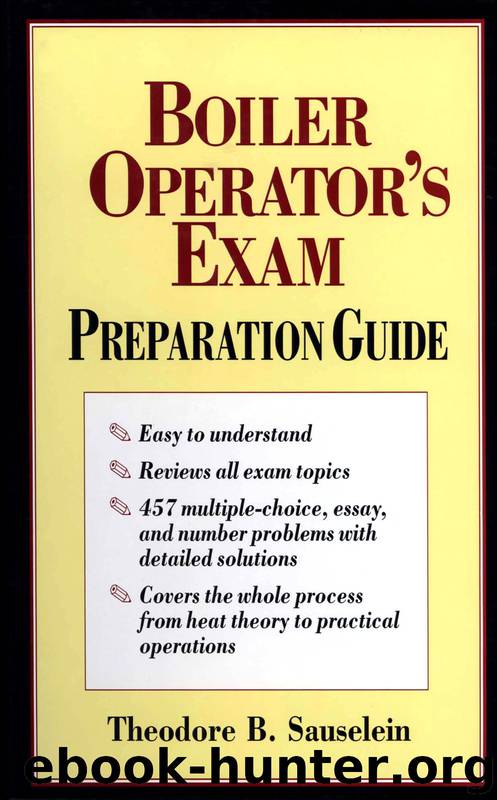Boiler Operator's Exam Preparation Guide by Theodore Sauselein

Author:Theodore Sauselein
Language: eng
Format: epub
Publisher: McGraw-Hill Education
Published: 1997-08-05T16:00:00+00:00
Now use the second horsepower equation to make sure the answer is correct:
NET POSITIVE SUCTION HEAD AND CAVITATION
Cavitation is the formation and subsequent collapse of vapor-filled cavities or bubbles in the pumped liquid. These bubbles are formed when the pressure in the suction line falls below the pumped liquid’s vapor pressure — the force exerted by a gas on its container. (Just as flash steam is produced when the pressure of saturated water is reduced.) When these bubbles violently collapse with velocities exceeding the speed of sound as they reach the high-pressure side of the pump, a tremendous amount of energy is quickly released in a small area. These pressures exceed the tensile strength of the metal and cause pitting by blasting out metal particles.
The most obvious effects of cavitation are noise and vibration. Cavitation often produces noise that sounds like stones passing through the pump. Over time, impellers are damaged beyond repair. Perhaps you have seen a bronze impeller that looks like it has been severely pitted by corrosion. It’s likely that the damage was due to cavitation. The noise and vibration can also cause bearing failure, shaft breakage, and other fatigue failures. In addition, cavitation also reduces the pump’s efficiency and capacity.
Required net positive suction head (NPSH) is a characteristic of the pump and is data supplied by the manufacturer. It is the amount of head needed to overcome friction and flow losses in the pump’s suction, which keeps the pressure at the eye of the impeller above the vapor pressure of the liquid. If a pump is operated below its required net positive suction head, cavitation occurs. Available NPSH is a characteristic of the system and is calculated by the pump installer. It must be greater than the required net positive suction head at the suction connection of the pump.
Vapor pressure is the pressure at which liquid and vapor can coexist. The vapor pressure for water is on a steam table. For example, water at 212°F has a vapor pressure of 14.7 psia, while water at 50°F has a vapor pressure of 0.1781 psia.
It is easier to pump cold water than hot water. To cavitate water at 50°F, the pump’s suction pressure would have to be below 0.1781 psia. However, a slight drop below atmospheric pressure would cavitate water at 212°F.
Cavitation is avoided with the proper installation design that provides sufficient NPSH. The equation for available net positive suction head is as follows:
Download
This site does not store any files on its server. We only index and link to content provided by other sites. Please contact the content providers to delete copyright contents if any and email us, we'll remove relevant links or contents immediately.
1,001 ASVAB Practice Questions For Dummies by Powers Rod(4471)
ASVAB For Dummies by Powers Rod(2805)
Churchill by Paul Johnson(2544)
Police Exams Prep 2018-2019 by Kaplan Test Prep(2516)
Wonder by R J Palacio(2182)
Wiley CPA Examination Review Focus Notes by Kevin Stevens(1936)
1936941139 (N) by Bob Rosenthal(1867)
First Aid Handbook--Crucial Survival Skills, Emergency Procedures & Lifesaving Medical Information by Department of the Army(1810)
ASVAB AFQT For Dummies by Rod Powers(1646)
A Very Stable Genius by Philip Rucker & Carol Leonnig(1646)
Future Design by Unknown(1532)
1,001 ASVAB AFQT Practice Questions For Dummies by Angie Papple Johnston(1477)
U.S. Army Combat Pistol Training Handbook by Army(1471)
CISSP For Dummies by Miller Gregory Peter(1460)
Tests and Proofs by Unknown(1451)
The GED Crash Course by Alpha(1421)
Master the Civil Service Exams by Peterson's(1395)
McGraw-Hill Education 2,000 Review Questions for the CPA Exam by Denise M. Stefano(1366)
Court Officer Exam by Learning Express LLC(1362)
